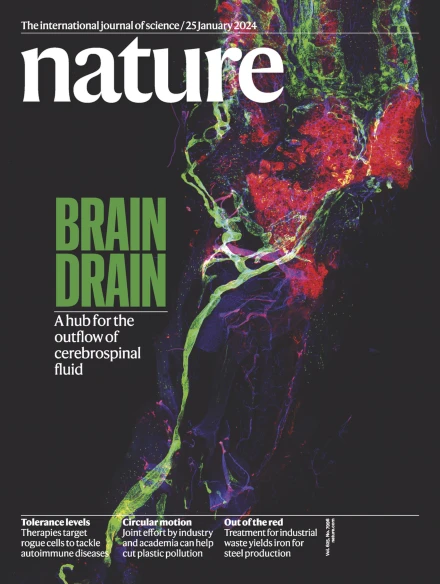深度视觉蛋白质组学绘制遗传性肝病的蛋白质毒性
IF 48.5
1区 综合性期刊
Q1 MULTIDISCIPLINARY SCIENCES
引用次数: 0
摘要
蛋白质错误折叠疾病,包括α1-抗胰蛋白酶缺乏症(AATD),对健康构成重大挑战,其细胞进展仍知之甚少1,2,3。我们使用空间蛋白质组学、质谱和机器学习来绘制人类肝脏组织中的AATD。将深度视觉蛋白质组学(Deep Visual Proteomics, DVP)与单细胞分析相结合4,5,我们探测了完整的患者活检,以解决肝细胞在纤维化阶段的假时间应激过程中的分子事件。我们从福尔马林固定的石蜡包埋组织中三分之一的单个细胞中获得高达4300个蛋白质的蛋白质组深度。该数据集揭示了一种潜在的临床可操作的过氧化物酶体上调,这种上调发生在规范的未折叠蛋白反应之前。我们的单细胞蛋白质组学数据显示α1-抗胰蛋白酶积累主要是细胞内在的,肝细胞之间的应激传播最小。我们将蛋白质组学数据与人工智能引导的基于图像的表型整合在几个疾病阶段,揭示了以球状蛋白聚集和独特的蛋白质组学特征为特征的晚期肝细胞表型,特别是包括TNFSF10(也称为TRAIL)量的升高。这种表型可能代表一个关键的疾病进展阶段。我们的研究为AATD的发病机制提供了新的见解,并为复杂组织的高分辨率原位蛋白质组学分析引入了一种强大的方法。这种方法具有揭示各种蛋白质错误折叠紊乱的分子机制的潜力,为理解人体组织单细胞水平的疾病进展设定了新的标准。本文章由计算机程序翻译,如有差异,请以英文原文为准。


Deep Visual Proteomics maps proteotoxicity in a genetic liver disease
Protein misfolding diseases, including α1-antitrypsin deficiency (AATD), pose substantial health challenges, with their cellular progression still poorly understood1–3. We use spatial proteomics by mass spectrometry and machine learning to map AATD in human liver tissue. Combining Deep Visual Proteomics (DVP) with single-cell analysis4,5, we probe intact patient biopsies to resolve molecular events during hepatocyte stress in pseudotime across fibrosis stages. We achieve proteome depth of up to 4,300 proteins from one-third of a single cell in formalin-fixed, paraffin-embedded tissue. This dataset reveals a potentially clinically actionable peroxisomal upregulation that precedes the canonical unfolded protein response. Our single-cell proteomics data show α1-antitrypsin accumulation is largely cell-intrinsic, with minimal stress propagation between hepatocytes. We integrated proteomic data with artificial intelligence-guided image-based phenotyping across several disease stages, revealing a late-stage hepatocyte phenotype characterized by globular protein aggregates and distinct proteomic signatures, notably including elevated TNFSF10 (also known as TRAIL) amounts. This phenotype may represent a critical disease progression stage. Our study offers new insights into AATD pathogenesis and introduces a powerful methodology for high-resolution, in situ proteomic analysis of complex tissues. This approach holds potential to unravel molecular mechanisms in various protein misfolding disorders, setting a new standard for understanding disease progression at the single-cell level in human tissue. High-resolution spatial proteomics were used to map molecular events during hepatocyte stress in pseudotime across all fibrosis stages, recapitulating known disease progression markers and revealing early peroxisomal activation and late-stage proteotoxic phenotypes.
求助全文
通过发布文献求助,成功后即可免费获取论文全文。
去求助
来源期刊

Nature
综合性期刊-综合性期刊
CiteScore
90.00
自引率
1.20%
发文量
3652
审稿时长
3 months
期刊介绍:
Nature is a prestigious international journal that publishes peer-reviewed research in various scientific and technological fields. The selection of articles is based on criteria such as originality, importance, interdisciplinary relevance, timeliness, accessibility, elegance, and surprising conclusions. In addition to showcasing significant scientific advances, Nature delivers rapid, authoritative, insightful news, and interpretation of current and upcoming trends impacting science, scientists, and the broader public. The journal serves a dual purpose: firstly, to promptly share noteworthy scientific advances and foster discussions among scientists, and secondly, to ensure the swift dissemination of scientific results globally, emphasizing their significance for knowledge, culture, and daily life.
 求助内容:
求助内容: 应助结果提醒方式:
应助结果提醒方式:


